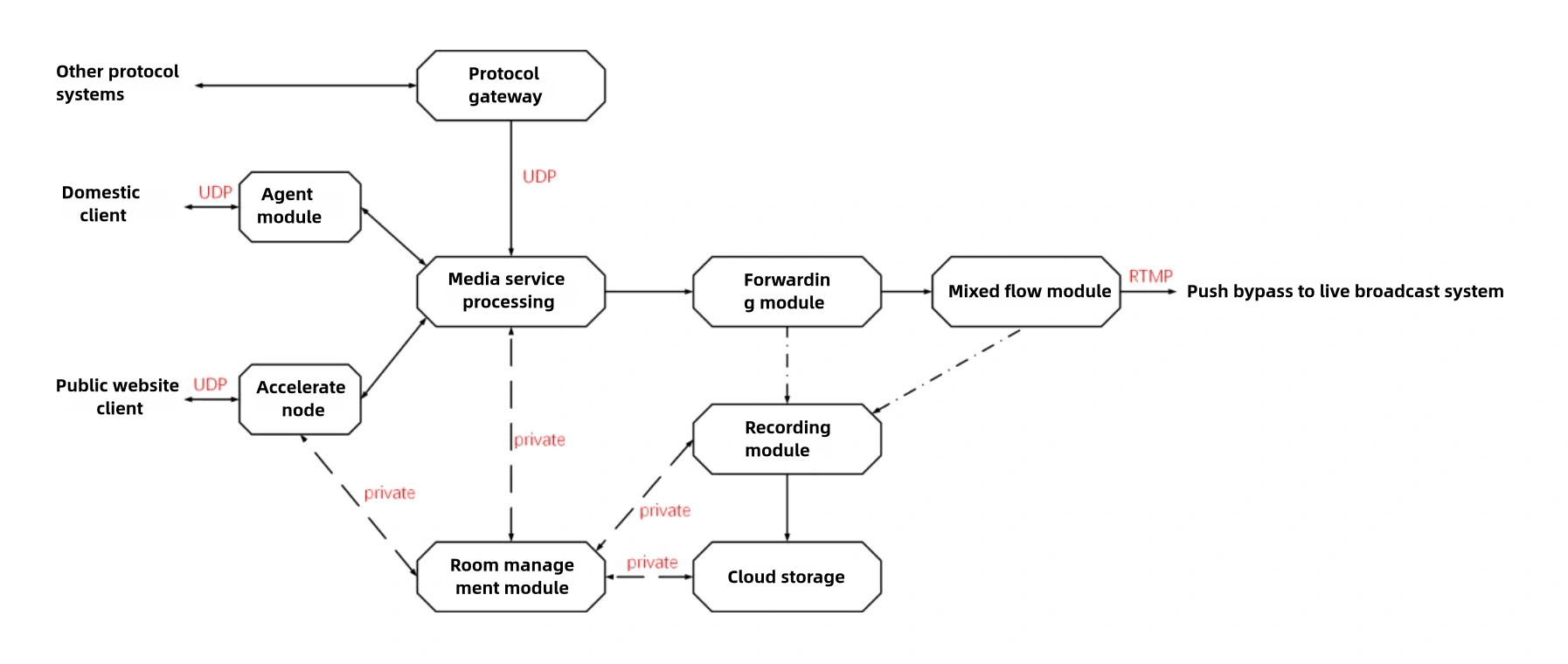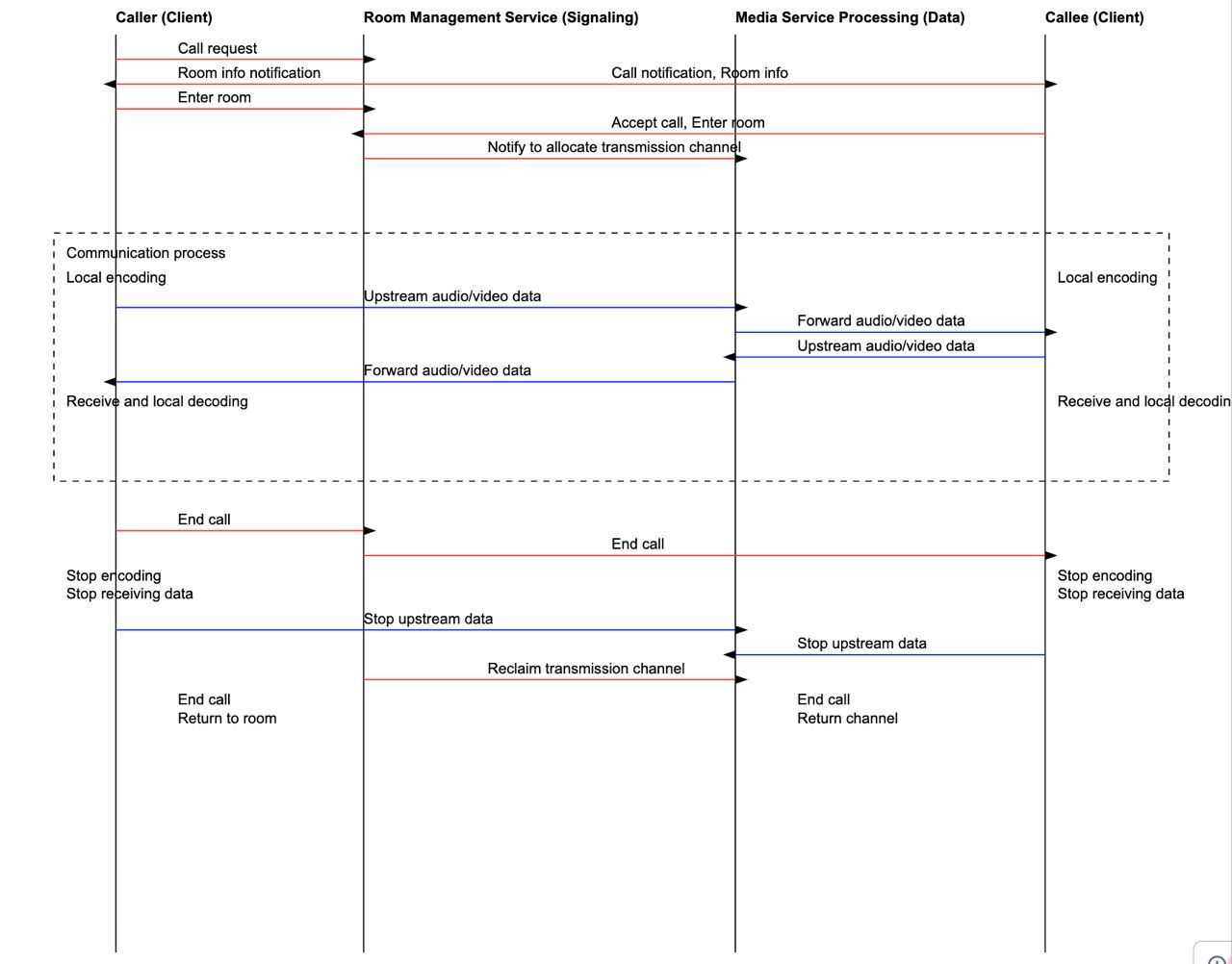In the era of digital connectivity, real-time audio and video communication systems have become an integral part of our daily lives. From video conferencing to online gaming, these systems enable instant, face-to-face interactions across vast distances. This blog post will delve into the intricate architecture that powers these real-time communication platforms, exploring each component and how they work together to deliver seamless, low-latency experiences.
Overview of Real-Time Audio and Video Architecture
At its core, a real-time audio and video communication system consists of several key components:
- Room Management Module
- Media Service Processing Module
- Forwarding Module
- Mixing Module
- Recording Module
Let's visualize this with a diagram:

This diagram illustrates the flow of data and signaling in a typical real-time communication system. Now, let's break down each component and process in detail.
Key Components
1. Room Management Module
The Room Management Module is the brain of the system, responsible for:
- Creating and managing virtual rooms for communication
- Handling signaling between participants
- Coordinating the start and end of calls
2. Media Service Processing Module
This is the core component for handling audio and video data. It's responsible for:
- Receiving incoming streams from participants
- Processing and optimizing these streams
- Forwarding the processed streams to other participants
3. Forwarding Module
The Forwarding Module is responsible for routing audio and video data between participants. It ensures that each user receives the appropriate streams from other participants in the call.
4. Mixing Module
For scenarios like conference calls or when streaming to a live broadcast system, the Mixing Module combines multiple audio and video streams into a single output stream.
5. Recording Module
The Recording Module captures and stores audio and video data from the call. It can operate in two modes:
- Individual recording: Saving each participant's stream separately
- Mixed recording: Combining all streams into a single recording
The Communication Process
Let's walk through a typical one-to-one call process, referencing the second diagram:

Call Initiation:
- The caller sends a signaling request to the Room Management Module to create a room.
- The Room Management Module creates the room and informs the caller.
Joining the Room:
- The caller enters the room and begins uploading audio/video data to the Media Service Processing Module.
- The Room Management Module notifies the callee about the incoming call.
Call Acceptance:
- If the callee accepts, they enter the room and also begin uploading their audio/video data.
Data Exchange:
- The Media Service Processing Module forwards each participant's data to the other.
- Both parties continuously encode and upload their local data while receiving and decoding data from the other party.
Call Termination:
- Either party can initiate call termination by sending a signaling request to the Room Management Module.
- Both parties stop uploading and receiving data.
- The Room Management Module closes the room and releases resources.
Multi-Party Calls
For multi-party calls, the process is similar, with a few key differences:
- Multiple callees are notified to join the room.
- Each participant uploads their data and receives data from all other participants.
- Participants can leave individually, with the room closing only when the last person exits.
Challenges in Real-Time Communication Systems
1. Scalability
In a room with M users, where N users are uploading data, there are N×M audio/video streams. This exponential growth presents significant scalability challenges, especially as the number of participants increases.
2. Latency
Real-time communication systems are extremely sensitive to delay, particularly in audio. Minimizing latency while maintaining quality is a constant challenge.
3. Quality vs. Performance
Balancing audio/video quality with performance is crucial. High-quality streams require more bandwidth and processing power, which can impact real-time performance.
4. Device Limitations
Most client devices have limited capabilities for concurrent encoding and decoding. This often necessitates limiting the number of simultaneous streams in a call.
5. Network Variability
Dealing with varying network conditions across different users while maintaining a consistent experience is a significant challenge.
Advanced Features
1. Side-Channel Live Streaming
The Mixing Module can combine multiple streams and push them to a live streaming system using protocols like RTMP, enabling features like webinar broadcasts.
2. Flexible Recording
The Recording Module's ability to save individual streams or mixed content provides flexibility for various use cases, from legal compliance to content creation.
Future Trends
As technology evolves, we can expect to see advancements in several areas:
AI-Enhanced Communication: Using artificial intelligence for noise suppression, background replacement, and real-time translation.
WebRTC and Browser-Based Solutions: Increasing adoption of web standards for real-time communication, reducing the need for dedicated apps.
5G Integration: Leveraging 5G networks for ultra-low latency and high-quality video calls, even in mobile scenarios.
Virtual and Augmented Reality: Integrating VR and AR technologies for more immersive communication experiences.
Conclusion
The architecture of real-time audio and video communication systems is a marvel of modern technology, combining various components to deliver near-instantaneous interaction across the globe. From the moment a call is initiated to its termination, a complex series of processes work in harmony to provide a seamless experience.
As we continue to rely more on digital communication, understanding this architecture becomes increasingly important. Whether you're a developer building the next big communication platform, a business leader considering implementing real-time communication tools, or simply a curious user, appreciating the intricacies of this technology can deepen your understanding of the digital world we inhabit.
The future of real-time communication is bright, with ongoing innovations promising even more natural, immersive, and accessible experiences. As we look ahead, it's clear that the architecture of these systems will continue to evolve, adapting to new technologies and meeting the ever-growing demands of users worldwide.